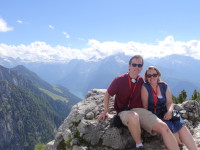 We got launched today and were on the road around 9:00, leaving Hall behind. I was a little sad to leave the Tirol region behind since we left a lot of cool-sounding things undone. Next trip to Austria.
We got launched today and were on the road around 9:00, leaving Hall behind. I was a little sad to leave the Tirol region behind since we left a lot of cool-sounding things undone. Next trip to Austria.
We headed northwest, going into Germany, then back into Austria, and finally back into Germany. Wait, you say! Your trip was to Austria! This was the start of Meredith’s days of the trip, and Meredith is dedicated to the travel writer Rick Steves. For some reason (proximity, I assume), Rick Steves includes a small corner of Germany in his Austria book, so Meredith considers it fair game. This is okay since today was very interesting to me; plus, the area is so beautiful.
We drove to the town of Berchtesgaden, where we stopped at a tourist information building, where we were to pick up a bus to go tour Obersalzberg, the mountain retreat of Hitler, which includes the mountain-topping Kehlsteinhaus (the Eagle’s Nest). That sounded very exciting to someone like myself who is interested in history, especially modern history. We got there around 11:30, and the tour was at 1:00, so we had some time.
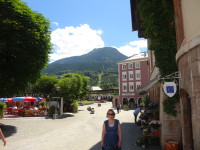 This was a case of Meredith being cautious, and for good reason. With the influx of refugees, we were told sometimes Germany checks passports at the border, and sometimes not. When they do check them, the wait can be an hour. Today we did not have that problem — the guards waved us by without us stopping. However, the extra time was appreciated by me in that I was not usually very happy getting out of the slow lane, especially in Germany. The highway was two lanes, and as far as I can tell, either by choice or by law, the heavy truck traffic cannot go faster than 50 or 55 mph. But, in Germany, the speed limit was almost 80 mph, which meant some cars were pushing 90. So, if you are in the slow lane, and you want to pass, you need to wait for an opening large enough that the 30-40 mph difference is not going to be an issue. Mostly, I sat behind trucks.
This was a case of Meredith being cautious, and for good reason. With the influx of refugees, we were told sometimes Germany checks passports at the border, and sometimes not. When they do check them, the wait can be an hour. Today we did not have that problem — the guards waved us by without us stopping. However, the extra time was appreciated by me in that I was not usually very happy getting out of the slow lane, especially in Germany. The highway was two lanes, and as far as I can tell, either by choice or by law, the heavy truck traffic cannot go faster than 50 or 55 mph. But, in Germany, the speed limit was almost 80 mph, which meant some cars were pushing 90. So, if you are in the slow lane, and you want to pass, you need to wait for an opening large enough that the 30-40 mph difference is not going to be an issue. Mostly, I sat behind trucks.
That said, it took two and a half hours to get to Berchtesgaden instead of two, so I was happy to have the extra time. We used it to grab a light lunch at a cafe, and then we walked along the river and then up the hill into the old town. By the time we spent ten minutes there, we had to head back to where we were meeting our bus.
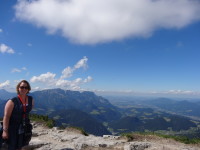 Our German guide spoke excellent English, and she gave us little radio receivers to hear her even when the group spread out, as often happened in the confined spaces we were visiting. We drove up the mountain in a full-sized tour bus, which I was happy to let someone else do. The guide gave us background on Hitler, some of which I either had not known or had forgotten — both of Hitler’s parents died before he was a young man, he applied to art school and did not get in, he seems to have lived an itinerant/homeless life for a few months, and started reading about politics in the men’s homes he stayed at. He was in WW 1 for the German army (the Austrians, his home country, said he was not physically fit to serve in the Austrian army), and his eyes were injured with mustard gas toward the end of the war. He quickly worked his way up through the Nazi party, and helped plan a revolt against the government, which failed, and he served nine months in prison for treason, where he wrote volume one of Mein Kampf. As he rose to be the German Chancellor, the Nazis pressured and bullied people into selling their property on the mountain so Hitler and the high officials of the Nazi party could have a retreat and planning center where Hitler’s home was.
Our German guide spoke excellent English, and she gave us little radio receivers to hear her even when the group spread out, as often happened in the confined spaces we were visiting. We drove up the mountain in a full-sized tour bus, which I was happy to let someone else do. The guide gave us background on Hitler, some of which I either had not known or had forgotten — both of Hitler’s parents died before he was a young man, he applied to art school and did not get in, he seems to have lived an itinerant/homeless life for a few months, and started reading about politics in the men’s homes he stayed at. He was in WW 1 for the German army (the Austrians, his home country, said he was not physically fit to serve in the Austrian army), and his eyes were injured with mustard gas toward the end of the war. He quickly worked his way up through the Nazi party, and helped plan a revolt against the government, which failed, and he served nine months in prison for treason, where he wrote volume one of Mein Kampf. As he rose to be the German Chancellor, the Nazis pressured and bullied people into selling their property on the mountain so Hitler and the high officials of the Nazi party could have a retreat and planning center where Hitler’s home was.
Enough background — we got off the bus on the main living level of the mountain, which housed 250 soldiers and various officials, had a kindergarten, and had Hitler’s home as well as the homes of several top generals and officials. Almost all of the buildings were destroyed by the Allies to keep the area from becoming some sort of shrine to Hitler, but a few buildings remain, and our guide pointed out where the various missing buildings used to be. I had not known that the mountain was under American control as a recreation area for U.S. troops until 1995, when it was returned to the German government. They built a museum showing how Hitler rose to power, how people put their hope in him, and the disastrous results of Hitler’s ideas and programs. It looked like it was really well done, but we had to walk though it for the sake of time — we were trying to get to the bunkers.
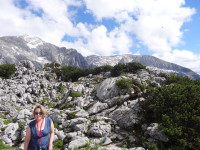 There were over four miles of tunnels and bunker built, but they were not started until 1943 when the officials started to sense the war was turning. As such, some of the bunkers and tunnels were never finished or connected up, and a couple of tunnels were not discovered until as recently as 2000. That was actually very interesting, though, as we could see the process of how building bunkers and tunnels actually happened – drilling out rock, then cement, then brick, then waterproofing, then more brick and cement. The walls of the most important bunkers were five feet thick.
There were over four miles of tunnels and bunker built, but they were not started until 1943 when the officials started to sense the war was turning. As such, some of the bunkers and tunnels were never finished or connected up, and a couple of tunnels were not discovered until as recently as 2000. That was actually very interesting, though, as we could see the process of how building bunkers and tunnels actually happened – drilling out rock, then cement, then brick, then waterproofing, then more brick and cement. The walls of the most important bunkers were five feet thick.
We toured through several tunnels, and got to see where the French had carved graffiti in May of 1945. The area surrendered peacefully (the Nazis left just before the Americans and French got there), so the few places damaged by shrapnel or bombs were damaged by soldiers blowing off steam. We got to see large shelter areas that could hold 300 people and the partially installed machine gun nests that were supposed to guard the entrances. It was all very fascinating to me.
We all then boarded another bus that took us up and up and up Hitler’s private road to the Eagle’s Nest retreat. The road and the Eagle’s Nest were a 50th birthday present to Hitler from the Nazi party, at the minor cost of about $300 million (in today’s money): the most expensive works project since Mad King Ludwig’s castle in Neuschwanstein sixty years before. I had not known that the Eagle’s Nest was a day-retreat house — there were no bedrooms. Hitler is recorded as only going there fourteen times. Happy birthday indeed.
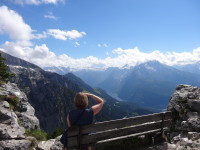 The Eagle’s Nest was going to be blown up by the Allies in 1950, but the German government asked that it be spared, as it had no military value. The Allies agreed, as long as it never contained a museum to Hitler. The Germans put in a restaurant, which still serves food today.
The Eagle’s Nest was going to be blown up by the Allies in 1950, but the German government asked that it be spared, as it had no military value. The Allies agreed, as long as it never contained a museum to Hitler. The Germans put in a restaurant, which still serves food today.
The Eagle’s Nest is most easily accessed from the parking lot by a long tunnel and an elevator (both of which are mostly original) that travels up over 300 feet. You can then climb on a path even higher, past a cross monument to the workers who died building the road (about ten or so, most from a mudslide), and up to several hiking trails. Meredith and I climbed up to a good high point, where she relaxed and wondered at the view from about 6100 feet, while I tried to not freak out.
We had a total of about an hour of free time up on the Eagle’s Nest, and then we went back to the nerves-of-steel driver and his bus, which took us back to the tour bus, which took us back to town and to our car. The entire trip took a little over four hours. It was a great tour, although I would have loved an afternoon in the museum. Happily, we had a beautiful day today to tour and admire the mountains — often the Eagle’s Nest is fogged in, so we were fortunate.
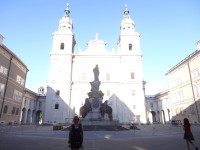 Back at the car, we drove on to Salzburg, about twenty minutes away, where we checked into our farm B and B. Some farms rent out a few rooms to supplement their income, and that is where we were staying, on the edge of Salzburg, but still on the urban bus line.
Back at the car, we drove on to Salzburg, about twenty minutes away, where we checked into our farm B and B. Some farms rent out a few rooms to supplement their income, and that is where we were staying, on the edge of Salzburg, but still on the urban bus line.
One of the more interesting things to do in a foreign country where you do not speak the language is to try to figure out mass transit. After settling in our rooms, we were told by our hostess to catch bus 21 into the city. We forgot to ask where to pick it up on returning, and that got interesting. Obviously, we managed, but it involved spotting the #21 bus and jogging to catch it as it pulled in a half-block away from where we thought it was going to pick us up. And then we had to listen very carefully for the announcement of our stop, since we were more or less listening for sounds that sounded like the name of our stop, since we did not understand the words themselves. It all worked out.
Anyway, we took the bus into the city center and the old town section of Salzburg, which boasts the most impressive castle I have seen anywhere. It is huge. The old town also has several churches of such huge size, I thought we had found the cathedral at one point when we had not. That will mess up your navigation by landmarks.
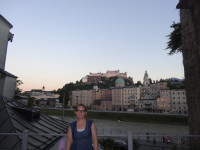 We grabbed some stir-fry for supper, and then ice cream for dessert (“large” does not seem to translate well, as I got one scoop). We then trekked across the river to the medieval part of the city, because the old town was not old enough. Along the way, we had an amazing sunset that kept lighting up buildings in brilliant ways. We wandered the narrow main street of the medieval city, coming through its old main gate. We did get to see a building whose corner was damaged by an American in a tank when the tank did not quite fit. The building has since been renovated, but the scar was left as a reminder about how narrow the street was. I heeded it and did not take my tank down there.
We grabbed some stir-fry for supper, and then ice cream for dessert (“large” does not seem to translate well, as I got one scoop). We then trekked across the river to the medieval part of the city, because the old town was not old enough. Along the way, we had an amazing sunset that kept lighting up buildings in brilliant ways. We wandered the narrow main street of the medieval city, coming through its old main gate. We did get to see a building whose corner was damaged by an American in a tank when the tank did not quite fit. The building has since been renovated, but the scar was left as a reminder about how narrow the street was. I heeded it and did not take my tank down there.
We wandered across the river and back along the river, very much enjoying the cool evening and watching Austrians at play along the river and in bars and cafes. It is a fine place, made better by the fact we figured out how to get home.
Ice cream: always specify the number of scoops you want. As you discovered, one scoop is the default.
Glad you enjoyed Salzburg – a beautiful town, but often mobbed by tourists. Ask me about the “boys will be boys” garden sometime.
And I understand your reluctance to leave Tyrol. We spent a week there and it wasn’t nearly enough (we’ve already agreed to go back some day and stay west of Innsbruck).